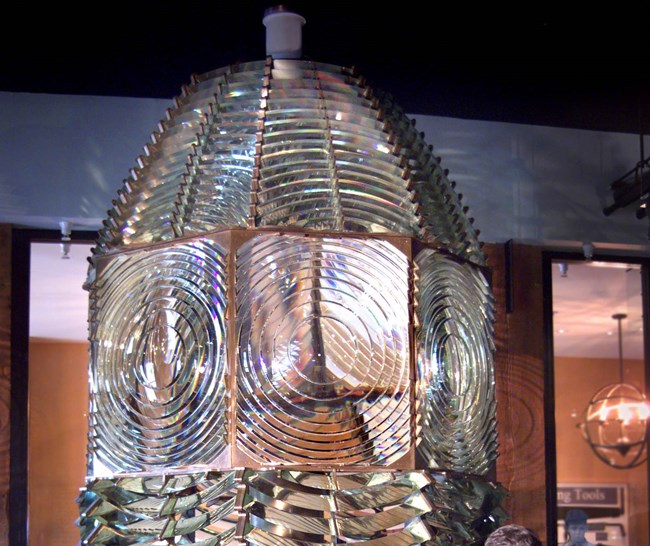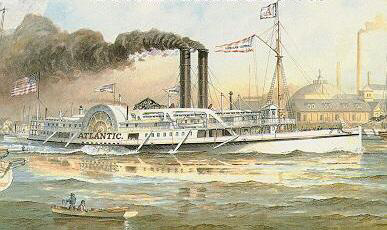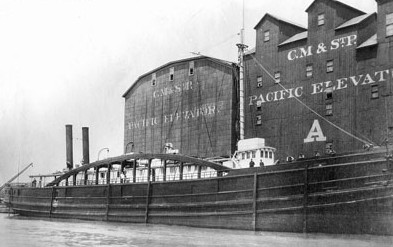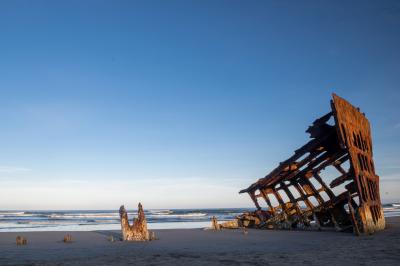Building a Shipwreck Exhibit
Author Spotted Leaving a Seedy Motel by 'Most of my Friends'
On a bright and cheery fall day several years ago, I was judiciously attempting to leave a local motel with a less than spectacular reputation. It was early afternoon and I was cautiously stepping away from the motel guest office with an armload of stuff. Stupidly, I had parked about as far from the office as the parking lot would allow. I pulled my hat down and schlepped along a row of other cars, but to my horror, the sound of a car horn pierced an otherwise serene afternoon. Someone I knew waved frantically and I sheepishly waved back. Phones would be ringing off the hook that evening. "Guess where I just saw Dave Frew?" "What do you suppose he was doing there?" "Hmmm!"
I knew what they were thinking, but there was an explanation. Believe it or not. In January 1997, I took over as executive director of Erie County Historical Society and Museums, a wonderful organization that had fallen into difficulty after a merger that combined the Historical Society (now Hagen History Center) on State Street and in Girard, with the Historical Museum at West Sixth and Chestnut streets. I began my tenure at the new multilocation organization with a marketing study from which I learned that one of the organization's perceived flaws was a lack of innovative or new exhibits. With museum space on State Street right in the middle of Erie's busy downtown it seemed logical (at least to me) to create a shipwreck exhibit. I had written books and papers about Lake Erie shipwrecks, immersed myself in the culture of wreck diving, and intuitively "knew" that an exhibit would be popular. With a small grant and a generous community benefactor, I remodeled the interior of the State Street History Center, carving out enough space to house an ambitious new exhibit space. Then I went to work hunting for exhibit materials.
My friendship with Ontario shipwreck hunter Dave Stone had alerted me to the terrible way that many Lake Erie shipwrecks had been destructively harvested for souvenirs that went to private collectors. When I first met Dave, I was treated to his collection of bits and pieces of Lake Erie wrecks that had been inappropriately ripped or pried loose from ships. He had dozens of these ill-gotten artifacts at his Long Point cottage. It was common practice during the early days of wreck hunting for searchers to descend to a ship, especially one in shallow water, and shred it of anything that could be pulled loose. Hatches, masts, winches, anchors, portholes and other defining components were taken, and sometimes destructively. With the easily removable stuff gone, wreck divers often tore away at structural members, removing planks from hulls, cargo from freighters, or large sections of ship interiors. By the time I had met Dave Stone in the early 1980s, that practice had long ended, largely because most of the relatively shallow water wrecks had already been found and destroyed by souvenir hunters and because of new regulations that prohibited such primitive practices.
But as I learned from Stone, once a person had a reputation for being a shipwreck guru (as he did), people brought items that they had been collecting. As he told me one day, some divers who had inappropriately taken bits and pieces of wrecks would eventually be overcome by guilt and search for legitimate ways to return the ill-gotten treasures. A board from a shipwreck that had served as a wonderful wall hanging in a recreation room had suddenly become a source of guilt. Or a surviving family member, facing the grim mission of cleaning out a parent's odd belongings after he or she was moved to a nursing home, saw a wooden board with a brass name place, identifying it as a deck board from an 1854 schooner and had second thoughts about tossing it in a Dumpster. Even though it has been decades since he had "collected" pieces of shipwrecks, himself, Dave Stone had managed to assemble a huge collection of such artifacts. People brought them because they assumed that he would know what to do with them. And he did. Dave filled several regional museums with ill-gotten relics, and he still had a barn full at his Long Point cottage.
With a mission to create a new Erie collection for the History Center, I consulted both Stone and my friend Ian Bell, who was the director of Port Dover's Harbour Museum. Like Stone, Bell had a back room filled with bits of shipwrecks that had come to him in the same way. People brought things that Grandpa had collected, just before they threw them out. Both Stone and Bell loaned me items for our exhibit and I "imported them" with notes stating that I was a museum curator with on-loan artifacts. At about the same time, I sent a plea letter to every regional organization that had anything to do with diving or exploring and within days, calls and letters began to arrive.
 The Fresnel lens was a French invention that helped to greatly magnify a very small light source. [National Park Service]
The Fresnel lens was a French invention that helped to greatly magnify a very small light source. [National Park Service]
The Erie County Historical Society already had several great items that I planned to use as the core of the new exhibit. We had pieces of the U.S. Brig Niagara, the U.S. Brig Lawrence, and the U.S.S. Michigan/Wolverine in our storage area. And we had (possibly inappropriately) acquired the Fresnel light from the Erie Land Lighthouse that then-Mayor Joyce Savocchio had loaned for safekeeping years earlier when she worried that it could be damaged by vandals. Our talented technical director Dave Pugh built a small lighthouse with a motion-sensing device so that the Fresnel lamp blinked when anyone walked by, and the Fresnel became a mini-display used to mark the entrance to the "Maritime Exhibit Center." We had ship models that included the Edmund Fitzgerald, commercial fishing equipment, nets, and a rapidly expanding collection of actual shipwreck relics. During the final stages of organizing the exhibit, we received a call from "the motel." The owner said that when the Mar-Dive group was in Erie working on the wreck of the Steamer Atlantic they had given her items from the wreck but she had no interest in them. If I would pick them up, the museum could have them. They were artifacts from Lake Erie's most important shipwreck.

The Steamer Atlantic was the target of the Mar-Dive salvage group from California. [AqVisions.com]
During the mid-1980s after Port Dover diver Mike Fletcher had found the remains of the Steamer Atlantic, which sunk in 1852, news of his discovery reached a California salvage group. Mar-Dive came to Erie, set up a motel headquarters, and began diving on the Atlantic. Using an odd set of legal manipulations, it claimed the salvage rights to the classic ship, even though it was in Canadian waters and seemingly protected by strict Ontario preservation laws. Mar-Dive made quite a news splash while in Erie, constantly issuing televised press releases about their progress on the wreck and proudly showing artifacts it had salvaged. It made several nasty comments about Mike Fletcher, whom they claimed illegally dove on the Atlantic. Fletcher launched a legal fight, which he ultimately won and, during the protracted struggle for ownership of the Atlantic, new laws were passed to make it strictly illegal to even touch a sunken wreck, much less take artifacts. Meanwhile, Mar-Dive was claiming to have harvested hundreds of things from the sunken ship, although there were those who suspected that they had been "salting" the wreck with otherwise-ordinary 19th century stuff.
In the world of antiques, a random 1850-era frying pan might be worth $35 but if it had been recovered from the Steamer Atlantic it was "priceless." Why not "produce" a frying pan or two (plus a lot of other stuff) and claim that it had been taken from the Atlantic? Eventually, Mar-Dive left town in a hurry, went back to California, and abandoned much of the stuff it had removed from the Atlantic.
When I visited the motel to inspect the items that were being offered, the steps leading into the main office seemed unusual but somehow familiar. They were made of metal bars. The owner revealed that the Mar-Dive guys had built the steps for her, using salvaged materials from another shipwreck. A light went on as I recalled a 1984 local salvage attempt. The step bars were the same as the metal ingots that had been recovered from the Dean Richmond by a salvage diver. Gary Kozak made quite a local splash when he announced that he had located a treasure ship that sunk just east of Erie and that he was salvaging its gold and silver ingots.
Controversy erupted over his work when he blew a hole in the hull to facilitate the salvage work. Kozak had searched for the wreck of the Dean Richmond for years, which had been reported to have sunk almost 50 miles east of where it was finally found. With the media gathered around his worksite at Erie's docks, Kozak returned from the first day of diving but the ingots that he displayed for television photographers were not gold or silver. They were plainly marked "zinc." When Kozak realized that the bulk cargo was zinc instead of gold or silver he pulled several bars out, showed them to the news media, and abandoned his efforts. His controversial use of dynamite to blow a hole in the hull of the old ship caused some consternation and the "salvage" of the Richmond changed Lake Erie wreck preservation dramatically. Each American border state as well as the Province of Ontario passed laws prohibiting divers from removing things.
The motel steps were obviously made from several bars of zinc that Mar-Dive had removed from the Dean Richmond during a practice dive before they traveled to the Atlantic. The Richmond is in 105 feet of water off North East, where it sunk in 1893, taking its crew of 18 as well as a cargo that included hundreds of zinc bars that were headed for Buffalo. The wreck of the Dean Richmond is almost diveable for advanced recreational divers at 105 feet, but the Atlantic, which is in 165 feet of water, is too deep for anyone but a skilled commercial diver with mixed gas capabilities as well as a safety system, including a re-compression chamber.

The Dean Richmond with her wooden hogging arches was not a particularly attractive ship. [GenDistasters]
When I inquired about the makeshift stairs, I was told that I could have them, too, if I were to replace them with a proper set of steps. The Mar-Dive guys had given them to the motel and left them there. An odd assignment for the curatorial staff but not difficult. With artifacts from the Atlantic and the Dean Richmond to add to the parade of other stuff that had been showing up as a result of letters sent from the museum, the Maritime exhibit was filling up. The only challenge remaining was to pick up the stuff at the motel. And to do so in a subtle way. Several trips were required to drag the new artifacts out to my car and, as I made the first circuit, I began to wonder about how I would explain my presence at this disreputable place to anyone who might see me.
But what was the chance that anyone would notice me? Pass by just then? Just as I popped open the tailgate of the station wagon, a shrill car horn pierced the otherwise silent afternoon, a hand waved and the driver yelled my name. Another horn startled me as I turned to walk back to the motel for a second load. The third and a fourth horn blast happened during the next load. I groaned and waved back. The final load was accompanied by even more salutes from West 12th Street. With a sense of relief, I closed the car and started to pull out of the driveway, but there were two more horns and waves as I was exiting the driveway. What was the chance?
The shipwreck exhibit was a success and spawned more donations. It continued at the State Street History Center for several years before it was taken down and placed in storage. When Presque Isle's Ridge Center created its shipwreck exhibit a few years ago, several of the artifacts were brought out and loaned to the designers.
Historian and author David Frew, Ph.D., is an emeritus professor at Gannon University, where he held a variety of administrative positions during a 33-year career. He is also emeritus director of the Erie County Historical Society/Hagen History Center and is president of his own management consulting business. Frew has written or co-written 35 books and more than 100 articles, cases, and papers.


.png)
